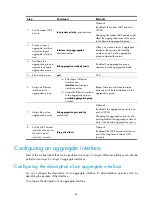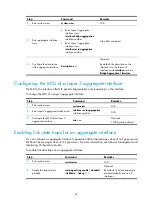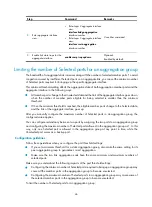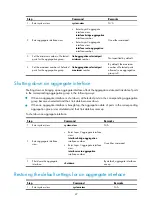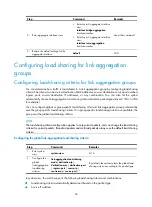
42
Step Command
Remarks
4.
Assign an Ethernet
interface to the
aggregation group.
a.
Enter Layer 2 Ethernet
interface view:
interface
interface-type
interface-number
b.
Assign the Ethernet interface
to the aggregation group:
port link-aggregation group
number
Repeat these two sub-steps to assign
more Layer 2 Ethernet interfaces to
the aggregation group.
5.
Assign the port an
aggregation priority.
link-aggregation port-priority
port-priority
Optional.
By default, the aggregation priority
of a port is 32768.
Changing the aggregation priority of
a port might affect the aggregation
state of the ports in the static
aggregation group.
Configuring a Layer 3 static aggregation group
Step
Command
Remarks
1.
Enter system view.
system-view
N/A
2.
Create a Layer 3
aggregate interface and
enter Layer 3 aggregate
interface view.
interface route-aggregation
interface-number
When you create a Layer 3
aggregate interface, the system
automatically creates a Layer 3
static aggregation group numbered
the same.
3.
Exit to system view.
quit
N/A
4.
Assign an Ethernet
interface to the
aggregation group.
a.
Enter Layer 3 Ethernet interface
view:
interface
interface-type
interface-number
b.
Assign the Ethernet interface to
the aggregation group:
port link-aggregation group
number
Repeat these two sub-steps to
assign more Layer 3 Ethernet
interfaces to the aggregation
group.
5.
Assign the port an
aggregation priority.
link-aggregation port-priority
port-priority
Optional.
By default, the aggregation priority
of a port is 32768.
Changing the aggregation priority
of a port might affect the
aggregation state of the ports in the
static aggregation group.
Configuring a dynamic aggregation group
To guarantee a successful dynamic aggregation, be sure that the peer ports of the ports aggregated at
one end are also aggregated. The two ends can automatically negotiate the aggregation state of each
member port.

















